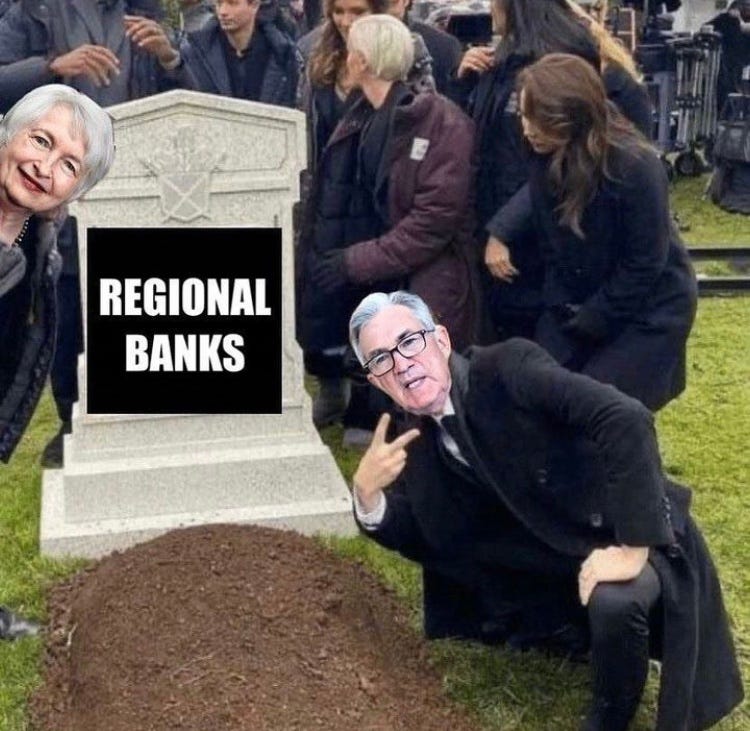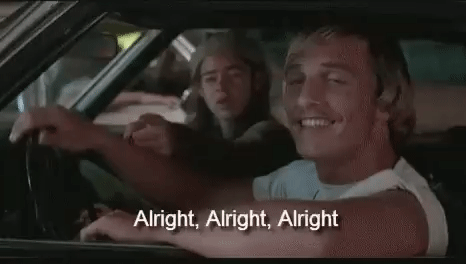It's All Happening
As Banks Fail, Do We Opt to Save Them or Preserve the Value of the US Dollar?
The Fed aggressively hiking rates until something breaks…
Your money in the bank not really being yours…
It’s all happening.
While I’ve recently written about the above topics in this newsletter, I’m not here to say “I told you so” because 1.) I take no pleasure in doing so and 2.) It didn’t take a rocket scientist to see all of this coming.
The big questions I’d like to explore in this edition of the newsletter are the following:
As US banks continue to fail, will the US Treasury and the Fed choose to keep the banking system solvent or continue in their mission to fight inflation? And can they do both simultaneously?
Let’s dive in.
Money Printer Back On
The Fed has already turned the money printer back on.



The fancy new term for money printing this time around is Bank Term Funding Program (BTFP).


The BTFP is a program in which Federal Reserve Banks can offer loans to “eligible borrowers” in exchange for said borrowers pledging US Treasuries, mortgage-backed securities and other qualifying assets.
What’s most important to note about the BTFP for the purpose of the questions being explored in this edition of the newsletter is that the program will likely lead to a continued expansion of the Fed’s balance sheet, while the Fed had been working to reduce its balance sheet in efforts to rein in inflation.
Why do we need the BTFP right now?
In the wake of Silicon Valley Bank’s (SVB) collapse — the second largest bank failure in US history — the US government and the Fed determined that they needed to step in to restore confidence in the US banking system.
The Fed, with the help of the US Treasury, has agreed to backstop $175 billion in deposits at SVB.
Why did we need the Fed and the US Treasury to step in at SVB?
The current banking insurance system — the FDIC — only insures investors’ deposits up to $250,000 per depositor.

Even if the US government were to have made an exception in this case and decided to use FDIC funds to bail out all depositors at SVB, it wouldn’t have even been possible to fully do so.
The FDIC fund only has about $126 billion in it, which means that if the US Treasury were to drain it to make SVB depositors whole, it’d still come up approximately $50 billion short.
While it’s wild to think that the US’s bank insurance fund isn’t even large enough to cover depositors at one non-Big 4 bank, it’s even wilder to think that 186 other banks have vulnerabilities similar to SVB.
Let’s pause here to do some math.
Let’s say these 186 other banks also needed to be backstopped via the BTFP.
Then, let’s say that these other banks only needed a quarter of what SVB needed as a backstop — which would be about $43.75 billion.
186 banks x $43.75 billion = $8.1375 trillion
In this hypothetical scenario, the Fed would need to add another $8.1375 trillion to it’s balance sheet — just about doubling it — at a time when it’s supposed to be reducing it to fight inflation.
Now, I have no idea whether all 186 of these banks will really need help, and I’m likely off in assuming they each might would need something in the ballpark of $43.75 billion, but I think you get my drift.
If more banks go under and look to the Fed for a backstop, then the Fed’s balance sheet has to expand.
But then we also have to consider how the US government and the Fed will decide which banks to save/are worth saving?
Let’s go to US Secretary of the Treasury Janet Yellen to hear her scientific approach to that one.
Janet Yellen Overrides the Notion of the Market Economy

TL;DW (though I wish you did) - If the Fed and Janet Yellen think that a bank’s failure to protect uninsured depositors would create systemic risk, then they’ll bail that bank out.
Let me explain what sort of effect this has.
Banks now know that the US Treasury in conjunction with the Fed will bail them out if their failure will result in contagion that could lead to the collapse of the banking system (first in the US and then likely, as a result, in many other parts of the world).
This kind of assurance creates an even higher rate of moral hazard — when a party engages in risky behavior and fails to act in good faith because it knows another party bears the consequences of its poor behavior — in our system, which is already rife with moral hazard.
Put more simply, if banks are big enough, they can do whatever they want because they know that the US Treasury and the Fed are there to backstop them.
But who is the other party who bears the consequences of banks’ poor behavior?
Well, my friend, if you use US Dollars, it’s you.
“Too big to fail” banks have been granted a license to do whatever they’d like at the expense of the US Dollar.
We now have what analyst Jim Bianco calls a two-tiered banking system…

…and having this sort of system will do further damage to both the regional banks that depositors feel aren’t “too big to fail” and the value of the US Dollar.
Three things will likely happen as a result of regional banks failing, two of which have already begun to occur:
More and more people and businesses will begin to bank with Big 4 Banks, giving Big 4 Banks more power
Big 4 Banks will help bail out regional banks in exchange for ownership of them, giving Big 4 Banks more power
Regional banks will simply go under, giving Big 4 Banks more power
And the more powerful and bigger Big 4 Banks get, the more “too big to fail” they will become, which means that the US Treasury and the Fed will have to continue to favor them over the value of the US Dollar.
A market economy is supposed to root out and punish bad (insolvent) actors, but, according to what Yellen said in the video above, she and members of the Fed get to decide if those bad actors can even be punished without causing a crisis.
Put another way, the people in charge of money in the US continue to further destroy the country’s market economy.
Why is it important to have a market economy? Because, if you don’t, you get even more unelected bureaucrats and administrators making more decisions like the one’s that Yellen and Powell are making in the absence of a completely destroyed pricing mechanism.
(Without going too far off on a tangent here, I will say that I am in favor of a progressive taxation scheme that serves to provide social welfare and human services, as I don’t think a market economy alone automatically distributes resources adequately. I’m simply against lobotomizing the pricing mechanism, because doing so presupposes that board of bureaucrats is more intelligent than all of the information that goes into every transaction that takes place in our economy. More on that in another edition of the newsletter, though.)
When a system centralizes to such a degree — when bureaucrats and administrators protect bad actors in the name of “stabilizing” the system — the system actually becomes further destabilized, and these scenarios tend to not end well.
So, to answer my initial question(s)…
No, I don’t think the US Treasury and the Fed can save the US banking system and preserve the value of the US Dollar. I think they have to continue to choose one or the other, and I have little doubt that they will continue to choose the banking system.
That’s just my humble opinion, though.
I don’t pretend to know all of the levers that can be pulled to get us out of the predicament we’re currently in or what a factor like over 80% of the world’s debt being denominated in US Dollars plays in this situation.
However, I do end up thinking to myself:
“Man, wouldn’t it be so awesome if we had a network and an asset that solved both the issue of banking counterparty risk AND the devaluation of currency? It would so be so cool if we had such a network and an asset — especially as the deterioration of the old system accelerates.”


Best,
Frank
Twitter: @frankcorva







